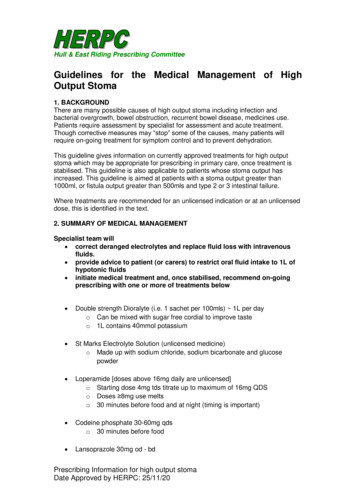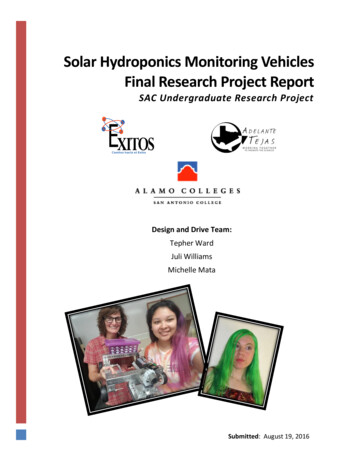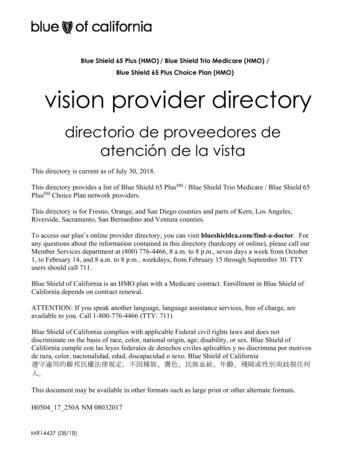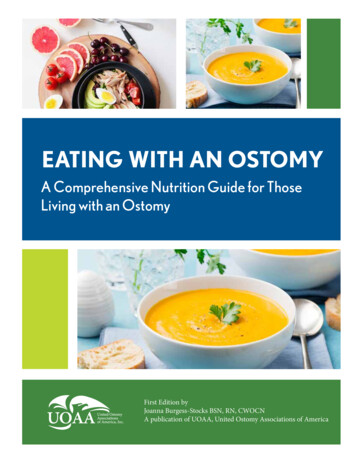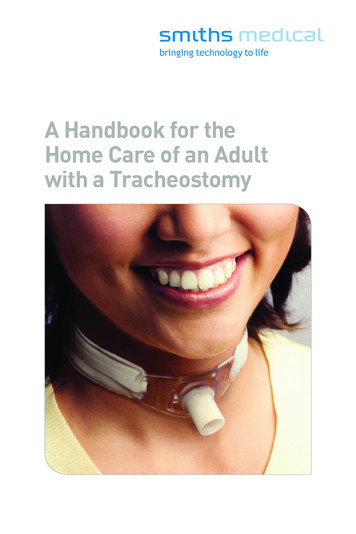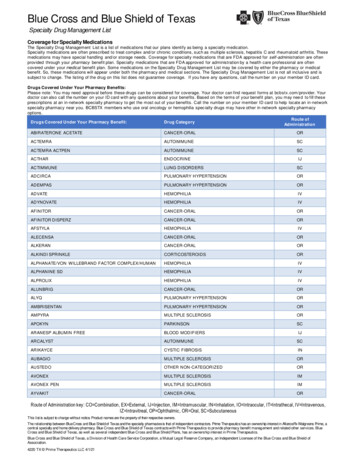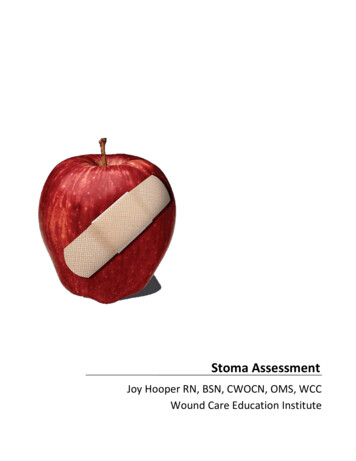
Transcription
Stoma AssessmentJoy Hooper RN, BSN, CWOCN, OMS, WCCWound Care Education Institute
The information in this handout reflects the state of knowledge, current at time of publication; however, theauthors do not take responsibility for data, information, and significant findings related to the topics discussed thatbecame known to the general public following publication.The recommendations contained herein may not be appropriate for use in all circumstances. Decisions to adoptany particular recommendation must be made by the practitioner in light of available resources and circumstancespresented by individual patients.Acknowledgements: This handout and presentation was prepared using information generally acknowledged tobe consistent with current industry standards. The authors whose works are cited in the Bibliography Section ofthis manual are hereby recognized and appreciated.All product names, logos and trademarks used in this presentation are the property of the respective trademarkowners. and denote registered trademarks in the United States and other countries."The use of NPUAP/EPUAP/PPPIA material does not imply endorsement of products or programs associated withthe use of the material."Wound Care Education Institute (WCEI)25828 Pastoral Dr.Plainfield, IL 60585Fax: 877-649-6021Phone: 877-462-9234Email: Info@wcei.netWebsite’s: www.wcei.netwww.woundcentral.comCopyright 2016 by Wound Care Education InstituteAll Rights Reserved.WCEI grants permission for photocopying for limited personal or educational use only.This consent does not extend to other kinds of copying, such as copying for general distribution, for advertising orpromotional purposes, for creating new collective works, or for resale.
Ostomy 101: Key Steps for an Accurate Stoma AssessmentObjectives: Upon completion of this activity participants will be able to:1) Define key terminology used in ostomy management2) Identify five clinical characteristics assessed during a stomal and peristomal skinassessmentI.DefinitionsA. The terms ostomy and stoma are general descriptive terms that are often usedinterchangeably, though they have different meanings. 11. What is an Ostomy? – Ostomy is a term used to describe a general surgicalprocedure operation in which an artificial opening is formed.2. What is a stoma? — A mouth-like opening; orifice, or opening on a surface; visiblepart of an ostomy. Fecal and urinary stomas consist of mucous membrane or thelining of the intestine that is exposed to the surface.B. What is effluent? Terminology used to describe the discharge, output from a stoma;waste material such as fecal matter, mucous, or urine; may be a liquid, solid, or gaseousemission.C. What is a Diversion? - Surgical creation (ostomy) of an alternative route for effluent(waste products) of the gastrointestinal tract or of the Urinary Tract and can be describedas “Continent or Incontinent”.1. Continent diversion - where the effluent flow can be managed without externalpouches or collection devices by the creation of internal reservoirs (pouch)2. Incontinent diversion – effluent waste products flow from the body spontaneouslyD. Pouching Systems1. Pouch – AKA bag (However do not refer to it as a “bag”); designed to catch andcontain stoma effluent (stool/urine). The pouch is made of plastic and is held to thebody with an adhesive, (skin barrier).2. Skin Barrier – AKA ‘barrier’, ‘wafer’, or ‘faceplate’; is adhesive; adheres to the skinaround the stoma; helps to protect skin from stoma output, and attaches the pouch tothe body.3. Appliance - refers to the entire containment system, the pouch, and the skin barrier;can be either a one piece or two piece systems; can also come in ‘closed end’ or‘drainable’ models. Also known as (AKA) pouching system.II. Stoma FactsA. Stool and flatus or urine passes through the stoma after surgical intervention rather thanthrough the rectum or bladder.1. There is no voluntary control of gas or stool expelled through the stoma.B. There is no sensation in the stoma because there are no sensory nerve endings in thisarea.C. The stoma has a mucous-lined inner surface that continually produces mucous, anormal function of the intestines, which cleanses the stoma.1. The small amounts of mucous produced can be wiped clean or rinsed with water.D. Rectal discharge of mucous may occur with some patients with a stoma.1. Mucous varies in consistency from clear “egg white” to opaque, thick “sticky glue”both of which are considered “normal”.E. Stomas are vascular and may bleed slightly when rubbed or irritated—this is normal.III. Stoma AssessmentA. Collection of data that characterizes the status of the stoma and the surroundingperistomal skin.B. Performed by inspection (looking), palpation (touching), listening, and smell.C. Purpose-1-
1. Identification of signs and symptoms of complications2. Foundation for product selection - choices based upon thorough clinical assessment3. Essential for tracking progress or deterioration of the stomaD. Frequency – Based upon care setting1. Immediate Post-Opi. Assess stoma every 4 hours x 24 hours and then every 8 hours/prnii. Per Facility Policy2. Matured Stomai. Assessment upon each appliance change/patient visit, and documented weeklyat minimumE. Ideal Stoma Characteristics21. Moist, round, beefy red, budded shape2. Appearance similar to a rosebud3. Protrusion 2-3cm (20-30mm)4. Located on smooth portion of abdomen, away from beltlines, bony prominences,suture lines, and umbilicus5. Lumen in center of stoma1. Adequate surface area - two to three inches of flat surface surrounding stoma6. Location - Easily seen by patient - For many people, the best location is in the lowerquadrantF. Be methodical with assessment. Start in center of stoma and assess outward endingwith surrounding tissue.III. Location of StomaA. Abdominal Quadrant1. Four quadrants of the abdomen include the: Right upper quadrant, Left upperquadrant, Right lower quadrant, Left lower quadrant2. Imaginary line from the sternum to the pubis, through the umbilicus. Secondimaginary line is perpendicular to the first, horizontally across the abdomen throughthe umbilicus.B. UmbilicusC. Skin FoldD. BeltlineE. Bony ProminenceIV. Type of DiversionA. Intestinal1. Colostomyi. Ascending - located on the right side of the abdomen; effluent is high volume witha liquid-mush consistencyii. Transverse – located upper abdomen, either in the middle or toward the rightside of the body; effluent is a paste-like, soft substanceiii. Descending – located left lower side of abdomen (LLQ); effluent formed and solidiv. Sigmoid - located left lower side of abdomen few inches below descendingcolostomy (LLQ); effluent formed and solid2. Ileostomy – located right lower quadrant of abdomen(RLQ); effluent is semi-liquid tosoft, semi-fluid, paste-like consistency3. Continent Fecal Diversionsi. Continent Ileostomy (Kock Pouch) – located right lower abdomen just abovepubic hair line; effluent is liquidii. Ileoanal Reservoir (J-Pouch) – no stomaB. Urinary1. Urostomyi. Ileal conduit – located on the Right lower side of abdomen (RLQ)-2-
ii. Ureterostomy – two stomas; one on the right side of the abdomen and one on theleft side of the abdomen2. Continent Urinary Diversionsi. Indiana Pouch – located on the right lower side of abdomen or at umbilicusii. Mitrofanoff - located on the right lower side of abdomen or at umbilicusiii. Orthotopic Neobladder – no stomaV. Stoma ConstructionA. Temporary or PermanentB. The type or construction of the stoma: end stoma, loop stoma, or a double-barrel stoma.1. End stoma – one stoma with one openingi. A stoma is created from one end of the bowel. The other portion of the bowel iseither removed or sewn shut (Hartmann's procedure).2. Loop stoma - one stoma with two openings; one discharges stool, the secondmucus.i. A loop stoma is a stoma where both the upstream (proximal) and downstream(distal) openings of the bowel are brought out through the same place in theabdominal wall. The proximal opening of the stoma drains stool from theintestine, while the distal opening of the stoma (the mucous fistula) drains mucus.ii. Immediately after surgery presents with a rod or bridge. This device is left inplace until healing is accomplished.iii. Usually created for a temporary ostomy3. Double-barrel stoma – two distinct stomas; one discharges stool, the second mucus.i. The bowel is severed and both ends are brought out onto the abdomen and twodistinct stomas are made.ii. The stomas may or may not be separated by an expanse of skin.iii. One stoma is usually called the proximal stoma, while the other is called thedistal stoma.iv. The proximal opening of the stoma drains stool from the intestine, while the distalopening of the stoma (the mucous fistula) drains mucus.VI. Rods or Stents in PlaceA. Assess type, location and scheduled removal date.B. Bridge or Rod (Loop Stoma)1. Short, hard plastic tube or flexible plastic catheter that is placed under the loop of thestomai. L shaped bridge - A flat rod with one swivel end. The rod holds a loop of bowelabove the skin. (Skin barrier should be applied to cover the bridge)ii. Butterfly shaped bridge - folds in half along a hinge and forms a convenientcurved shape. It securely opens along its hinge and lays flat on the abdomen.iii. Plastic Rod with Rubber Tubing: The rubber tubing is connected to both ends ofthe rod to prevent the rod from slipping out. The rod may be gently slid verticallyto provide care to stoma site.2. The rod should slide easily back and forth under the stoma.3. The stoma should be over the middle of the rod and not pushed to one end of therod. If the stoma rubs up against the end of the rod the stoma can sustain damage inthe form of ischemia causing the tissue to die and slough off.4. Usually removed 7-14 days post opC. Stents1. Fine bore catheters inserted in urostomy surgery to prevent stenosis of theanastomosis between the ureter and the bowel.i. The ureteral stents originate in the renal pelvis, extend down the ureters, and exitthrough the stoma.32. May expel spontaneously, do not re-insert. Notify surgeon.-3-
3. Stents should drain urine all the time. Decreased urine output should be investigated.It can be caused by mucus plugs or dehydration.3VII. Stoma LumenA. The stoma lumen is the opening from which the effluent drains.B. Locations1. Descriptors: Centrally located, side, level with skin2. Ideally the lumen should empty from the top of the stoma3. Location of the lumen should be noted using the “clock method” with the patient’shead referenced as the 12 o’clock position.C. Number of lumensD. Stenosis – narrowing of the lumenVIII. Stoma MucosaA. Color1. Red - Healthy2. Dark Pink – Healthy3. Pale Pink – Healthy Urinary stoma; Fecal stomas: anemia, low hemoglobin4. Dark red/purplish tint - bruising5. Purple or Blue - lack of blood supply to the stoma6. Brown - melanosis coli a discoloration from excessive laxative use; lack of bloodsupply to the stoma7. Black – Necrosis; lack of blood supply to the stomaB. Appearance1. Shiny2. Taut – tight; stretched3. Edematous – normal finding post-op; gradually decreases over 6-8 weeks aftersurgery4. Dry5. Moist - The stoma is a mucous membrane and should always be moist with its ownnatural lubrication6. Textured – grooves; creases; rosebud appearance7. Smooth8. Bloody - superficial bleeding from the stoma during routine cleaning is normal. Stomatissue is highly vascularized, fragile and does bleed occasionally.i. Superficial bleeding that does not stop spontaneously, excessive bleeding, orprolonged bleeding may be indicative of a stoma complication.ii. Bleeding as a stoma complication can result from inadequate hemostasis duringstoma construction, portal hypertension, trauma, underlying disease, andbecause of some medications, such as prolonged use of analgesic antiinflammatory drugs, blood thinners, and chemotherapy.4iii. Luminal bleeding (bleeding that comes from the lumen of the stoma) is oftenassociated with underlying disease. The clinician should always notify thesurgeon regarding luminal bleeding. 49. Lacerated - stoma has been cut or torn10. Granuloma - small, red, raised areas on or around the stoma11. Necrosis - discolored and may be dark red, bluish, purple, or black. The stoma willbe limp, loose and flabby12. Varices - Purple skin discoloration with dilated, tortuous veins on the stoma 5C. Shape1. The shape of a stoma is round, oval, or irregular.2. Shape can vary with peristaltic movements of the intestine-4-
It is normal to be able to see movement of the stoma; stomas expand andcontract in a "wave-like motion" due to peristalsis. Some patients can see thismotion.3. The shape of the stoma is also affected by the individual’s body composition andtype of ostomyIX. Stoma Size and ProtrusionA. Protrusion1. The height or protrusion of the stoma is important not only for proper drainage butalso to conceal the stoma.2. The protrusion varies in length and can slightly retract or extend throughout the life ofthe stoma.3. The stoma height should be measured at the mucocutaneous junction where itattaches to the skin to top of stoma.4. A stoma can be:i. Flush — at skin levelii. Moderately protruding — one to three cm (10-30mm)7iii. Long protrusion — greater than three cm (30mm)7a. Greater risk for injury from trauma, laceration or being folded or bent over intothe pouching system 7iv. Retracted — below skin levelv. Prolapsed — telescoped away from the abdominal surfaceB. Size1. The size of the stoma varies due to the anatomic location of the ostomy.ii. An ileostomy will have a smaller stoma. The width of the small intestine is about2.5 cm.8iii. Colostomy size varies as the width of the colon varies and therefore, stoma sizewill vary. The colon can be anywhere from 2.5 cm at the small intestine junction,up to 6.3 cm in the transverse colon.8iv. Loop stomas are larger than end stomas. Loop stomas are constructed with sideof intestine rather than the end.8v. Ureterostomy is a small stoma as it is created from the ureter which has smalldiameter, compared to the ileal conduit which is created from the wider ileum.82. Round stomas are measured by circular diameter.3. Irregular or oval stomas are measured using the clock method with for length andwidth.C. Measurement1. Accurate measurements of the stoma are important to track the progress of theostomy but also to determine the correct size of the skin barrier and pouchingsystem.82. Measurements should be done frequently during the first six to eight weeks of thepost-operative period. (With each appliance change)3. The stoma should be measured at the base from mucosa to mucosa.84. Size is documented in millimeters or inches. (Skin barrier and appliance sizing areclassified according to either “mm” or “in”i. 1 inch 25.4 millimetersii. 1 centimeter 10 millimeters5. Round Stoma Measurementi. For appliance sizing measurement, use manufacturers stoma measurementguides.ii. For other diameter measurements, use transparent circular measurement rulers.a. Line the center of the transparent ruler over the center of the stoma andmeasure according to ruler instructions.i.-5-
6. Oval/Irregular Stoma Measurementi. For appliance sizing measurement irregular stomas should be traced and a copyof the tracing should be recorded for appliance fitting.a. Use a piece of plastic transparent material and place over stoma. (May usethe clear plastic packaging cover or paper backing from the skin barrier)b. Trace around perimeter of stoma onto transparency with pen or indeliblemarker.c. Label tracing indicating location of: head, feet, pouch side, skin side.d. To create skin barrier template: Cut out the center of the tracing. Place thetemplate/stencil on the back of the skin barrier wafer. Trace the completedpattern on the back of the skin barrier faceplate. Be sure to line it up so thatthe tail of pouch will be in the appropriate direction.ii. For detailed documentation measure length and width using the clock method.a. Consider stoma as face of clock. 12:00 points to patients head, 6:00 pointstoward the patient‘s feetb. Length 12:00 - 6:00 patients head & feet as guidesc. Width 3:00 - 9:00 side to side7. Stoma Measuring Cardsi. Most of the manufacturers will provide them free of charge, and most cut-to-fitproducts will contain one per box.ii. The card comes with numerous pre-cut holes, measured in millimeters and/orinches.iii. Select the hole in the card that fits closest around the base of the stoma withouttouching it. (approximately 1/8” larger than the stoma)iv. Most common sizes:a. 5/8” (16mm)b. 3/4" (19mm)c. 7/8" (22mm)d. 1"(25mm)e. 1 1/8" (29mm)f. 1 1/4" (32mm)g. 1 3/8" (35mm)h. 1 ½” (38mm)i. 1 5/8” (41mm)j. 1 3/4" (45mm)X. Stoma EffluentA. Fecal Stoma1. Amount of outputi. Postop Colostomy - There may be no fecal output for several days. First 24-72hrs. post-op may have a serosanguineous discharge then begins to expel formedstool as food intake increases.ii. Postop Ileostomy - Initial output: usually 12 –24 hours postop –dark green,viscous, odorless7; as the patient eats the output will thicken.2. Consistency of output – Thick, Viscous, Liquid, Pasty, Oily, Formed, Soft, Thin, Tarry,Bloody3. Odori. Presence or Absenceii. Strong, foul, pungent, fecal, musty, sweet4. Flatusi. Presenta. Post op flatus is the first sign that the bowel is starting to function again.b. Bowel sounds may not return until 24 to 72 hours after surgery. 9-6-
ii. Amount: Large, Moderate, Minimala. The average number of gas passages is about 13 to 21/day. Objectivelyrecording flatus frequency (using a diary kept by the patient) is a first step inevaluation if perceived excessive. 10B. Urinary Stoma1. Post Op Urostomy – Functions immediately, for 24-36 hrs. the output is blood-tingedand contains mucus threads2. Volume3. Consistency – Gritty, cloudy, crystals, mucous4. Color – Straw, amber, clear, blood tinged5. Odori. Presence or Absenceii. Musty, fishy, fecal, fruity, ammonia, acidicC. Stoma Function Status: Non-functioning (not passing flatus or stool)XI. Mucocutaneous JunctionA. Definition: The skin/stoma junction where the mucosa of the stoma is approximated tothe skin surrounding the stoma.8B. In the initial postoperative period, sutures will be present.1. This area should be treated as a wound until the junction of the skin and the mucosaare healed and sutures are removed.2. Document number and status of sutures. e.g. 5 sutures noted around perimeterbase of stoma, all sutures intact and free from redness, drainage, and crusting.C. Normal appearance is distinct difference in stoma tissue and surrounding skin.1. The mucocutaneous junction should be free of tension, infection, and skinbreakdown.2. Stoma should be intact with surrounding skin.D. If a separation is noted between stoma and surrounding skin, document measurements(width and depth) and location of the separation.8XII. Peristomal SkinA. Peristomal plane – surface area that extends out from the base of the stoma in area ofapproximately 4x4 inches (102mm x 102mm) 81. Assess peristomal plane at a minimum and extend assessment outward as neededbased upon findings.2. The skin around the stoma should be intact, without erosion, rashes or lacerations. 8B. Assess for:1. Colori. Healthy (no difference from adjacent skin surface)ii. Dusky (pale to bluish color)iii. Erythema (red)a. Redness may be caused by infection, irritation from drainage, urine/feces,dermatitis/trauma from tape or dressingb. Redness from infection may be seen as diffuse and indistinct, or as intensewith demarcated borders, red streaking. In dark skin, the skin may appearpurple or a gray hue or deepening of the ethnic skin coloriv. Bruised (Purple to yellowish color)v. Jaundice (yellow)vi. Staining2. Integrityi. Intact (no breakdown in skin)ii. Macerated (white friable skin, too much moisture)iii. Denuded (superficial skin damage)iv. Lesions-7-
v. Ulceration (a wound through the dermis layer)vi. Incisionvii. Scars - connective tissue reflective of dermal damage; new scars are pink andthick, over time become white and atrophic3. Texturei. Moistii. Crustyiii. Warmiv. Weepy4. Turgori. Normal (soft, good elasticity)ii. Flaccid (weak and flabby)iii. Firm (hard)iv. Edemav. Induration - process of the skin “becoming hard”; hardened mass with definededges; detected by palpation (feeling)C. Peristomal Pain1. PQRST Assessmenti. P Provokesa. What causes pain?b. What makes it better?c. Worse?d. Onset duration, variations, patternsii. Q Qualitya. What does it feel like?b. Is it sharp?c. Dull?d. Stabbing?e. Burning?f. Crushing?g. Throbbing, aching, squeezing, constant, intermittent, spasmodic, tender,crushing?h. Try to let patient describe the pain.iii. R Radiatesa. Location of pain - one site, several sites, does it move or radiate to anothersite, generalized or specific areab. Where does the pain radiate?c. Is it in one place?d. Does it go anywhere else?e. Did it start elsewhere and now localized to one spot?iv. S Severitya. How severe is the pain on a scale of 1 - 10?b. Utilize pain severity scale, be consistent with the scale with eachassessment, assess for severity at present, worst, and least levels.v. T Timea. Time pain started?b. How long did it last?2. Other questions to ask and look for.i. Vital signs – pulse, blood pressure, and respirationsii. Document verbal and nonverbal responses to pain3. Pain Historyi. Present pain management regimen and effectiveness-8-
ii. Pain management history - medications, interventions, etc.iii. Effects of pain - impact on ADL's such as sleep, appetite, emotions,concentration, social interactions4. Patients pain goalsi. Attitude toward use of pain medicationsii. Family expectations and beliefsiii. Typical coping response to stress or painiv. Knowledge about and preferences for pain management methodsD. Peristomal Skin Assessment Tools1. The Ostomy Skin Tooli. Developed as a comprehensive tool to use for documentation and grading of theperistomal skin.ii. The scoring system allows the health care provider to compare and contrast thecondition of the peristomal skin from one assessment to the next and makeadjustments to care as necessary.iii. The tool provides consistency to the peristomal skin documentation process. 15,16iv. The tool includes two simple approaches for obtaining information on thecondition of the peristomal skin:a. The DET (Discoloration, Erosion, Tissue overgrowth) Score – provides astandardized and validated way to score the peristomal skin through objectiveobservationsb. The AIM (Assessment, Intervention and Monitoring) Guide for PeristomalSkin Care – allows categorization of the peristomal skin disorder according toits cause and offers guidance on carev. Ostomy skin tool and instructions can be downloaded for free ationtools/theostomyskintool/2. The SACS Instrument18i. The SACS Instrument was developed to help establish a standard languagefor the assessment and classification of peristomal lesionsii. Provides operational definitions for the consistent interpretation of peristomal skinlesionsiii. A content validated measurement instrument to classify lesion type and locationiv. An objective classification system to document the incidence of peristomal skinlesionsv. . What is an ostomy? United Ostomy Associations of America (UOAA) Web site.http://www.ostomy.org/ostomy info/whatis.shtml. Accessed September 11, 2011.2. McCann, EM. Routine Assessment of the Patient with an Ostomy in Milne CT, Corbett LQ, Dubec DL,Wound Ostomy and Continence Nursing Secrets, Philadelphia, PA, 2003, Hanley & Belfus, Inc.2003;68:296-298.3. Incontinent urostomy: community care, follow-up and complications. In: Geng V, CobussenBoekhorst H, Fillingham S, Holroyd S, Kiesbye B, Vahr S. Incontinent urostomy. Arnhem (TheNetherlands): European Association of Urology Nurses (EAUN); 2009 Mar. p. 19-65.4. Barr JE. Assessment and management of stomal complications: a framework for clinical decisionmaking. Ostomy Wound Manage. 2004 Sep; 50(9):50-2, 54, 56.5. Rolstad BS, Erwin-Toth PL. Peristomal skin complications: prevention and management. OstomyWound Manage. 2004; 50(9):68-77.-9-
6. Sardina D. Ostomy Management Course Workbook. Wound Care Education Institute, Lake Geneva,WI; 2013.7. Carmel JE, Goldberg MT. Preoperative and Postoperative Management In: Colwell JC, Goldberg MT,Carmel JE, eds. Fecal & Urinary Diversions: Management Principles. St Louis, MO: CV Mosby; 2004;11:207-235.8. Colwell, JC. Principles of stoma management. In: Colwell JC, Goldberg MT, Carmel JE, eds. Fecal &Urinary Diversions: Management Principles. St Louis, MO: CV Mosby; 2004; 381-391.9. Colwell JC. Stomal and peristomal complications. In: Colwell JC, Goldberg MT, Carmel JE, eds.Fecal & Urinary Diversions: Management Principles. St Louis, MO: CV Mosby; 2004:224-225,310314.10. Bharucha, AE Gas Related Complaints in Beers MH, Berkow R. The Merck manual of diagnosis andtherapy. Whitehorse Station (NJ): Merck & Co., 2007. Accessed online strointestinal disorders/approach to the patient with lower gi complaints/gasrelated complaints.html11. Woo KY, Sibbald RG, Ayello EA, Coutts PM, Garde DE. Peristomal skin complications andmanagement. Adv Skin Wound Care. 2009 Nov;22(11):522-32.12. Wound, Ostomy, Continence Nurses Society [WOCN]. Peristomal skin complications: Best practicefor clinicians. 2007.13. Rolstad BS. Peristomal skin complications: Prevention and Management. Ostomy Wound Manage.2004;50(9):68-77.14. WOCN Society Clinical Practice Ostomy Committee. Peristomal hernia: Best practice for clinicians.Mt. Laurel, NJ: WOCN; 2011.15. Page AC. Two new tools for your ostomy practice. OWM. 2009:55(5);10.16. The Ostomy Skin Tool. 2009. Coloplast, Inc. Web site. Accessed on December 13, altools/theostomyskintool.17. Porrett T. The immediate postoperative period. In Porrett T, McGrath A (Eds) Stoma Care. BlackwellPublishing, Oxford,2005: 65-76.18. THE SACS INSTRUMENT ASSESSING AND CLASSIFYING PERISTOMAL SKIN LESIONSContent Validated. ConvaTec website. Accessed 9/29/2016 information/resources/the-sacs-instrument/19. Colwell JC. Postoperative Nursing Assessment Management. In Carmel JE, Colwell JC, GoldbergMT. (Eds.). Wound, Ostomy and Continence Nurses Society WOCN Core Curriculum: OstomyManagement. Philadelphia, PA: Wolters Kluwer, 2016; 9:113-119.Contact Information:Wound Care Education InstituteFax: 877-649-6021Phone: 855-391-1556Email: Info@wcei.netwww.wcei.net- 10 -
5. Lumen in center of stoma 1. Adequate surface area - two to three inches of flat surface surrounding stoma 6. Location - Easily seen by patient - For many people, the best location is in the lower quadrant F. Be methodical with assessment. Start in center of stoma and assess outward ending with surrounding tissue. III. Location of Stoma
